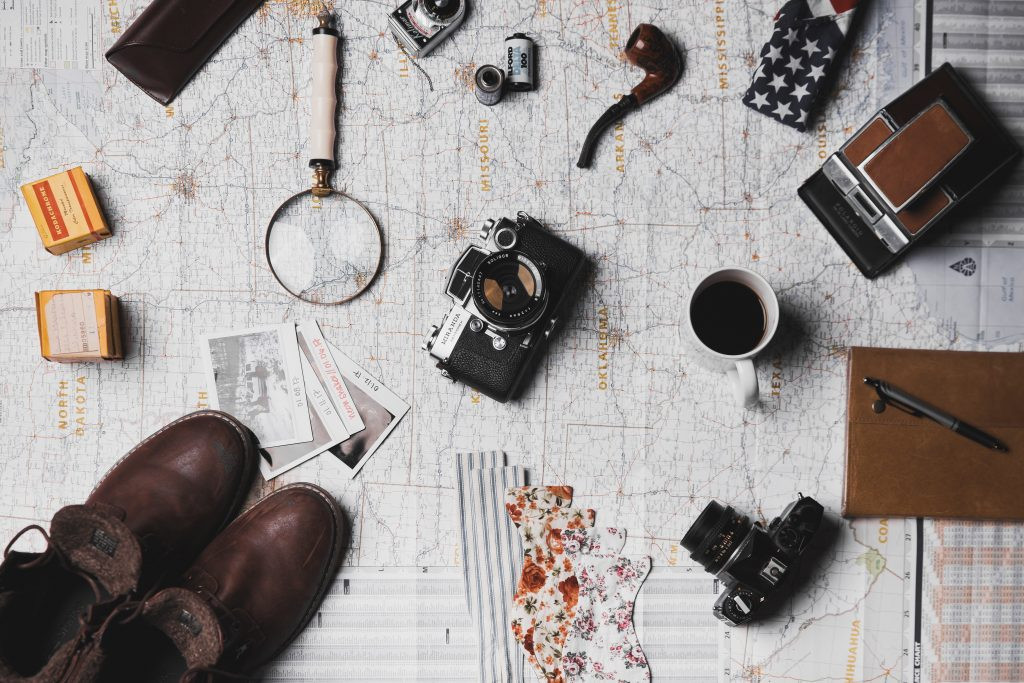Can You Fly With A Polaroid Camera? Yes, you can fly with a Polaroid camera, but protecting your film from X-ray damage is crucial. At flyermedia.net, we understand the concerns of instant photography enthusiasts and offer solutions to ensure your films remain unaffected during air travel, allowing you to capture those unforgettable moments without worry. Keep your films safe, capture great memories, and travel with peace of mind.
1. Understanding the Impact of X-Rays on Polaroid Film
The primary concern for travelers with Polaroid cameras is the effect of airport X-ray scanners on undeveloped film.
1.1 How Do Airport X-Rays Affect Undeveloped Film?
Airport X-rays primarily affect undeveloped film, potentially causing fogging or light streaks. Developed film, digital photos, and slides remain unaffected as the sensitive material has already been exposed and processed. Undeveloped film reacts to X-ray radiation because it is designed to be sensitive to light, awaiting exposure to create an image. X-rays can penetrate the film and cause unwanted exposure, leading to visible defects in your instant photos.
1.2 Visual Signs of X-Ray Damage on Polaroid Film
If your undeveloped film goes through a high-energy X-ray scanner, you might notice random fog stripes or unusual light patterns on your photos. According to Kodak, the severity of the fogging depends on the film’s ISO speed and the intensity of the X-ray. Higher ISO films are more sensitive and thus more prone to damage.
 Airport Security Scanner
Airport Security Scanner
1.3 Why Carry-On Baggage Scanners Are Generally Safer
The X-ray machines used for carry-on baggage are generally lower in intensity than those used for checked baggage. According to the Transportation Security Administration (TSA), the X-ray machines used for carry-on baggage are safe for most films under ISO 800.
2. Essential Precautions for Traveling with Polaroid Film
To safeguard your Polaroid film while traveling, consider these precautions:
2.1 Never Pack Undeveloped Film in Checked Baggage
Always pack undeveloped film or cameras with film inside your carry-on baggage. The high-intensity X-rays used for checked baggage can cause significant damage to the film, whereas carry-on baggage X-rays are much milder.
2.2 Request a Manual Inspection
When passing through security, politely request a manual inspection of your film and camera. Some airports allow manual inspection of photographic equipment and film, which bypasses the X-ray scanning process altogether.
 Requesting Manual Inspection
Requesting Manual Inspection
How to Request a Manual Inspection
- Approach the TSA agent: Be polite and patient.
- Explain your concern: Let them know you have undeveloped film and are concerned about X-ray damage.
- Request manual inspection: Ask if they can perform a hand inspection instead of X-raying the film.
2.3 Use Film Shield Bags
Consider packing your films inside a film shield bag, also known as a film guard bag. While the effectiveness of these bags is debated, they can add an extra layer of protection.
 Film Shield Bag
Film Shield Bag
2.4 Pack Smartly
Organize your carry-on bag in a way that allows easy access to your film. This can save time during security checks and make it easier to request a manual inspection.
2.5 Use Your Film During the Trip
To avoid the risk of X-ray damage on your return journey, try to use up your instant films during your trip. This way, you won’t have to worry about carrying undeveloped film back home.
3. Understanding Film Speed (ISO) and X-Ray Sensitivity
Film speed, measured in ISO, indicates how sensitive a film is to light. Lower ISO films require more light for proper exposure, while higher ISO films are more sensitive and better suited for low-light conditions. However, higher ISO films are also more susceptible to X-ray damage.
3.1 Low ISO Films
Low ISO films (below ISO 400) are generally less sensitive to X-rays. According to Fujifilm, films like Instax mini (ISO 800), Instax Wide (ISO 800), Polaroid Originals 600 (ISO 640), and SX-70 (ISO 160) can withstand low-energy X-ray scans without noticeable damage.
3.2 High ISO Films
High ISO films (ISO 800 and above) are more prone to X-ray damage. If you’re using high ISO film, taking extra precautions like requesting a manual inspection is essential.
3.3 What the Experts Say
- Kodak: Recommends requesting hand inspection for films of ISO 800 or higher.
- Fujifilm: Advises travelers to protect their films from X-rays, especially those with high ISO ratings.
4. Real-World Experiences and Case Studies
Many photographers have shared their experiences traveling with Polaroid film, offering valuable insights and tips.
4.1 Case Study 1: The Traveling Photographer
A professional photographer, Matt, shares his experience: “I always carry my Polaroid camera with me on trips. I’ve learned that requesting a manual inspection is the best way to protect my film. Most TSA agents are accommodating if you explain your concerns politely.”
 Polaroid Photography
Polaroid Photography
4.2 Case Study 2: The Family Vacation
A family traveling with young children shares their experience: “We packed our Instax film in a film shield bag and requested a manual inspection at the airport. The TSA agent was very helpful and ensured our film wasn’t damaged.”
4.3 Anecdotal Evidence
Online forums and photography communities often feature discussions about traveling with film. Many users report success with manual inspections and film shield bags. However, some also note instances where film was damaged despite precautions, highlighting the importance of using up your film during the trip.
5. Understanding Airport Security Procedures in the USA
Navigating airport security in the USA requires understanding the procedures and regulations set by the Transportation Security Administration (TSA).
5.1 TSA Regulations on Film and Cameras
The TSA allows both film cameras and undeveloped film in carry-on and checked baggage. However, they advise that high-speed film (ISO 800 or higher) should be protected from X-rays.
5.2 Requesting a Hand Inspection
You have the right to request a hand inspection of your film at any TSA checkpoint. It’s essential to be polite and patient when making this request. TSA agents are generally willing to accommodate if you explain your concerns clearly.
5.3 What to Expect During a Manual Inspection
During a manual inspection, a TSA agent will visually inspect your film and camera. They may also swab the film packaging for explosive residue. This process is usually quick and straightforward.
5.4 Common Misconceptions About Airport Security and Film
- Myth: All airport X-ray machines will damage film.
- Fact: Carry-on baggage X-ray machines are generally safe for films under ISO 800.
- Myth: Film shield bags are 100% effective.
- Fact: While they offer some protection, they are not foolproof.
- Myth: TSA agents always refuse hand inspections.
- Fact: TSA agents are usually accommodating if you make a polite request.
6. Tips for Storing and Protecting Polaroid Film
Proper storage and protection of your Polaroid film can further minimize the risk of damage during travel.
6.1 Optimal Storage Conditions
Store your film in a cool, dry place away from direct sunlight. According to Polaroid, the ideal storage temperature for their film is between 55-75°F (13-24°C).
6.2 Using Protective Cases
Consider using protective cases or containers to shield your film from physical damage and environmental factors.
6.3 Avoiding Extreme Temperatures
Extreme temperatures can negatively affect the quality of your Polaroid film. Avoid leaving your film in hot cars or freezing environments.
6.4 Checking Expiration Dates
Always check the expiration date on your film packaging. Expired film may produce unpredictable results.
7. Common Types of Polaroid Film and Their Sensitivity
Understanding the different types of Polaroid film and their respective sensitivities can help you make informed decisions about protection.
7.1 Polaroid Originals i-Type Film
Polaroid i-Type film is designed for use with newer Polaroid cameras. It has an ISO of 640 and is moderately sensitive to X-rays.
7.2 Polaroid Originals 600 Film
Polaroid 600 film is compatible with vintage Polaroid 600 cameras. It also has an ISO of 640 and requires similar protection.
7.3 Polaroid Originals SX-70 Film
Polaroid SX-70 film has a lower ISO of 160, making it less sensitive to X-rays compared to other Polaroid films.
7.4 Fujifilm Instax Mini Film
Fujifilm Instax Mini film has an ISO of 800 and is widely used in Instax Mini cameras. Due to its higher ISO, it’s more prone to X-ray damage.
7.5 Fujifilm Instax Wide Film
Fujifilm Instax Wide film also has an ISO of 800 and requires similar protection as Instax Mini film.
8. How Film Shield Bags Work (and Their Limitations)
Film shield bags are designed to reduce the amount of radiation that reaches the film inside. They are typically made of lead-lined materials that absorb X-rays.
8.1 Materials Used in Film Shield Bags
Film shield bags often use lead or other dense materials to block X-rays. According to various manufacturers, these bags can reduce radiation exposure by up to 90%.
8.2 Effectiveness of Film Shield Bags
While film shield bags can offer some protection, they are not foolproof. High-energy X-rays can still penetrate the bag, especially with prolonged exposure.
8.3 Limitations and Drawbacks
- Weight and Bulk: Film shield bags can be heavy and bulky, adding extra weight to your carry-on baggage.
- Inconsistent Protection: The level of protection can vary depending on the quality and construction of the bag.
- False Sense of Security: Relying solely on a film shield bag can lead to complacency and neglecting other precautions.
9. Alternative Photography Options for Travel
If you’re concerned about the risks associated with traveling with Polaroid film, consider alternative photography options.
9.1 Digital Cameras
Digital cameras are a convenient and worry-free alternative. They are not affected by X-rays, and you can easily back up your photos to avoid data loss.
9.2 Smartphone Photography
Modern smartphones offer excellent image quality and are incredibly convenient for travel photography.
9.3 Instant Digital Cameras
Instant digital cameras, like the Polaroid POP or Fujifilm Instax Square SQ20, combine the convenience of digital photography with the fun of instant prints. These cameras allow you to review and edit your photos before printing, reducing the risk of wasting film.
10. Exploring Flyermedia.net for More Aviation and Photography Tips
For those passionate about aviation and photography, flyermedia.net offers a wealth of information, resources, and expert advice.
10.1 Aviation Training and Career Opportunities
If you’re interested in pursuing a career in aviation, flyermedia.net provides valuable insights into flight training programs, pilot certifications, and job opportunities in the aviation industry.
- Flight Training Programs: Discover top-rated flight schools in the USA, including Embry-Riddle Aeronautical University, known for its comprehensive aviation programs.
- Pilot Certifications: Learn about the different types of pilot licenses and the requirements for obtaining them.
- Aviation Careers: Explore various career paths in aviation, such as commercial pilot, air traffic controller, and aviation technician.
Address: 600 S Clyde Morris Blvd, Daytona Beach, FL 32114, United States. Phone: +1 (386) 226-6000. Website: flyermedia.net.
10.2 Aviation News and Updates
Stay informed about the latest aviation news, technological advancements, and industry trends at flyermedia.net.
- New Aircraft Technologies: Read about the latest innovations in aircraft design and engineering.
- Airline Industry Trends: Get insights into the evolving landscape of the airline industry.
- Aviation Regulations: Stay up-to-date on the latest aviation regulations and safety standards.
10.3 Photography Tips and Guides
Enhance your photography skills with our comprehensive guides and tips, covering everything from basic techniques to advanced concepts.
- Travel Photography: Learn how to capture stunning travel photos with your camera or smartphone.
- Instant Photography: Discover tips and tricks for getting the best results with your Polaroid or Instax camera.
- Camera Reviews: Read our in-depth reviews of the latest cameras and photography equipment.
By exploring flyermedia.net, you can find valuable resources to enhance your knowledge and passion for both aviation and photography.
FAQ: Flying with a Polaroid Camera
1. Can I bring my Polaroid camera on a plane?
Yes, you can bring your Polaroid camera on a plane, but it’s essential to protect your undeveloped film from X-ray damage.
2. Will airport X-rays ruin my Polaroid film?
Airport X-rays can damage undeveloped Polaroid film, causing fogging or light streaks. Carry-on baggage X-ray machines are generally safer than those used for checked baggage.
3. How can I protect my Polaroid film from X-rays at the airport?
To protect your Polaroid film, pack it in your carry-on baggage, request a manual inspection, and consider using a film shield bag.
4. Is it safe to put Polaroid film in checked baggage?
No, it is not safe to put Polaroid film in checked baggage, as the high-intensity X-rays can cause significant damage.
5. What is a manual inspection, and how do I request one?
A manual inspection involves a TSA agent visually inspecting your film and camera instead of X-raying them. To request one, politely explain your concerns to the TSA agent at the security checkpoint.
6. Do film shield bags really work?
Film shield bags can offer some protection against X-rays, but they are not foolproof. It’s best to use them in combination with other precautions.
7. What ISO film is safe to take through airport security?
Films with ISO 800 or lower are generally safe to take through carry-on baggage X-ray machines.
8. Can I develop my Polaroid film before traveling to avoid X-ray damage?
Yes, developing your Polaroid film before traveling will eliminate the risk of X-ray damage, as developed film is not affected by X-rays.
9. Are digital cameras affected by airport X-rays?
No, digital cameras and digital photos are not affected by airport X-rays.
10. Where can I find more information about traveling with film and aviation tips?
You can find more information about traveling with film and aviation tips at flyermedia.net, where we provide expert advice and resources for enthusiasts.
Remember, the key to traveling successfully with a Polaroid camera is to be informed, proactive, and respectful of airport security procedures.
Now that you’re equipped with the knowledge and resources to protect your precious memories, head over to flyermedia.net and discover even more about aviation training, industry news, and photography tips!
